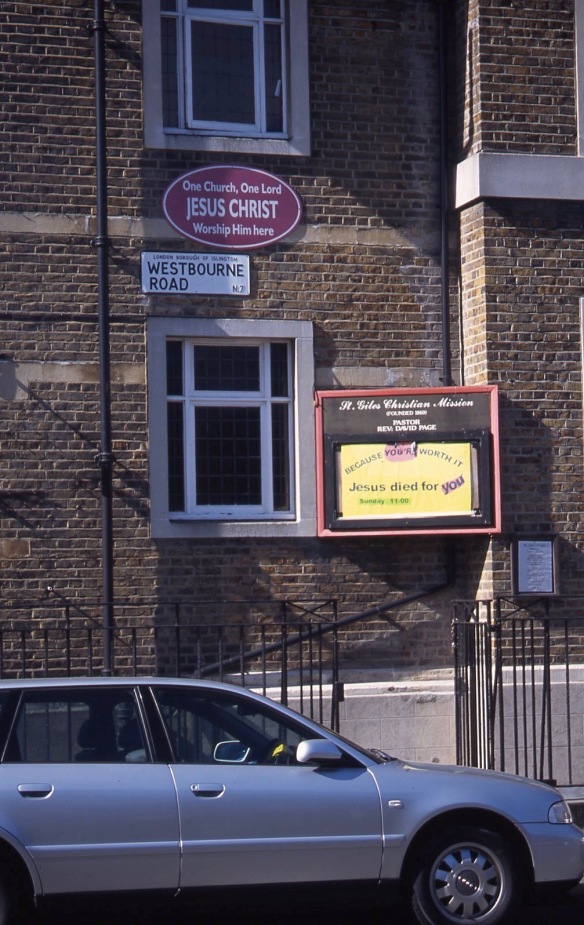CLICK ON IMAGES TO ENLARGE.
Today I returned to the Streets of London series and scanned the next dozen slides from September 2004.
The Sheldon Square development in the old Paddington Basin of the Regents Canal was still being built in the years immediately after the millennium. It probably sports an official road name now.
Wikipedia has a lengthy feature on Marwan Barghouti. This is the introductory paragraph:
‘Marwan Hasib Ibrahim Barghouti (also transliterated al-Barghuthi; Arabic: مروان حسيب ابراهيم البرغوثي; born 6 June 1959) is a Palestinian political figure convicted and imprisoned for murder by an Israeli court.[1] He is regarded as a leader of the First and Second Intifadas. Barghouti at one time supported the peace process, but later became disillusioned, and after 2000 went on to become a leader of the Al-Aqsa Intifada in the West Bank.[1][2] Barghouti was a leader of Tanzim, a paramilitary offshoot of Fatah.[3]
Israeli authorities have called Barghouti a terrorist, accusing him of directing numerous attacks, including suicide bombings, against civilian and military targets alike.[4] Barghouti was arrested by Israel Defense Forces in 2002 in Ramallah.[1] He was tried and convicted on charges of murder, and sentenced to five life sentences. Marwan Barghouti refused to present a defense to the charges brought against him, maintaining throughout that the trial was illegal and illegitimate. The Inter-Parliamentary Unionreviewed the case and said that Barghouti had been denied a fair trial.
Barghouti still exerts great influence in Fatah from within prison.[5] With popularity reaching further than that, there has been some speculation whether he could be a unifying candidate in a bid to succeed Mahmud Abbas.[6]
In the negotiations over the exchange of Palestinian prisoners for the captured Israeli soldier Gilad Shalit, Hamas insisted on including Barghouti in the deal with Israel.[7][8] However, Israel was unwilling to concede to that demand and despite initial reports that he indeed was to be released in the 11 October 2011 deal between Israel and Hamas, it was soon denied by Israeli sources.[9][10]
In November 2014, Barghouti urged the Palestinian Authority to immediately end security cooperation with Israel and called for a Third Intifada against Israel.[11]‘
In September 2004 this tent in Newcastle Place W2 provided a base for his supporters.
This corner of Praed Street stands opposite a side entrance to Paddington Station.
Over at Highbury Grove N1 in Islington, we see the common juxtaposition of different eating places, so common in London.
Linda Tyrie grew up in Baalbec Road N5. This is the opening paragraph of her article in the Journal of the Islington Archaeology and History Society of Summer 2013:
‘I grew up from 1944 to 1962 in the ground floor of a house in Baalbec Road, backing on to Highbury Fields. The fields and the beautiful avenues of trees formed a backdrop to my life – walking up Baalbec Road to the food office in Highbury Crescent/ Ronalds Road when I was very young with my mother’s coupon book to collect orange juice, and later walking through the Fields to Drayton Park school in Arvon Road and along Church Path through the fields to Brownies, Guides, church and Sunday school.’ (http://www.clcomms.com/iahs/201113/IAHS-summer-2013-web.pdf)

Highbury Terrace Mews
and Horsell Road N5, are both nearby.
The latter being just off Holloway Road, another demonstrating the cosmopolitan nature of London’s cafés, and the proliferation of graffiti. This brief history is from the Hidden London website:
‘The Holloway district takes its name from the road, which was known as the ‘hollow way’ (the road in a hollow) by the early 14th century, when it had become the City’s main route to the north. The hamlet of Ring Cross had grown up around the junction with Hornsey Road by 1494.
By the 17th century Holloway Road was notorious for its highwaymen but it became safer as houses began to connect Ring Cross with Lower Holloway, at the north end of Caledonian Road.
The construction of Archway Road brought an end to the area’s rural character in the 1820s. Holloway Road tube station opened in 1906, where Ring Cross had been. This section of underground line was constructed in tandem with the overhead railway running from King’s Cross to Finsbury Park – hence the station’s location, some distance from the more focal Nag’s Head locality. A prototype spiral escalator was installed at the station but never entered service.
Supermarkets have changed the face of Holloway Road over the last few decades. Sainsbury’s demolished a ravishing Victorian block of shops on their arrival in 1970. A Waitrose supermarket replaced Jones Brothers’ department store in 1993. This and the opening of a Safeway at Nag’s Head prompted Sainsbury to sell out to Kwiksave (who subsequently retreated in favour of an Argos superstore).
Generally, the road’s mix of retailers is typical of inner (as opposed to central) London high streets, with the colourful exception of a cluster of fetish fashion shops near the junction with Liverpool Road. Secondhand shops of all kinds are also in abundance.
The London Metropolitan University (formerly the University of North London) gained an iconic landmark in 2004 with the opening of its graduate school, the capital’s first building by the architect Daniel Libeskind; supplementing Rick Mather’s curved white block of 2000 and a brutalist concrete tower from its earlier days as a polytechnic.’
Hides Street
and Westbourne Road N7 are both within a stone’s throw of Islington’s Paradise Park. The latter is perhaps an appropriate location for the St Giles Christian Mission.
The barriers surrounding many of the capital’s roadworks, like these in Leverton Street NW5 in Kentish Town, bear the name Murphy.
This evening we dined on Jackie’s super spicy lemon chicken and crunchy vegetable rice. Neither of us imbibed.










